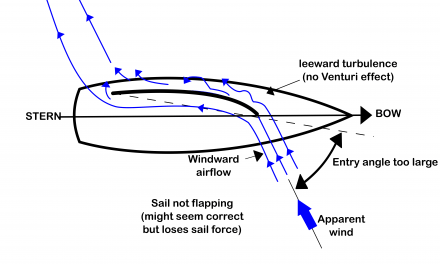Introduction.
In the first chapter of this on-line book “SAIL HANDLING AND TRIMING” we saw the theoretical foundations that help us to understand how the sail force is generated. In this second chapter, we are going to see a simple practical case of applying them to the most basic action on board a sailboat, which is the correct adjusting of a sail.
We will also introduce, in general, what we must control in a sail and the importance of the draft and the angle of incidence for a correct trimming, in order to obtain the maximum performance depending on the wind and sea conditions.
How do you properly trim a sail?
As we have already seen, the sail force is proportional to the angle of incidence, which is directly related to the sail draft; and as the angle of incidence increases, the sail force increases. As a general rule, with the maximum angle of incidence, we obtain the maximum pressure difference between both sides of the sail to generate the highest possible sail force.
However, above a certain angle of incidence, the sail force decreases sharply, as turbulence starts to occur on the leeward side of the sail and the Venturi effect stops working properly. In this case the sail may appear at first glance to be well hunted, but in reality we are losing sail power by not taking advantage of the Venturi effect and having too large an angle of incidence.
This simple reasoning, based on the theoretical foundations that we saw in the previous chapter, helps us to understand how to trim a sail correctly:
“Ease the sheet until the sail starts to luff, then stop easing, pull it in slowly, only the necessary to stop the sail lufting”. Efecúe Log In para desbloquear.Este contenido solo está disponible para subscriptores de navegantesoceanicos.com





